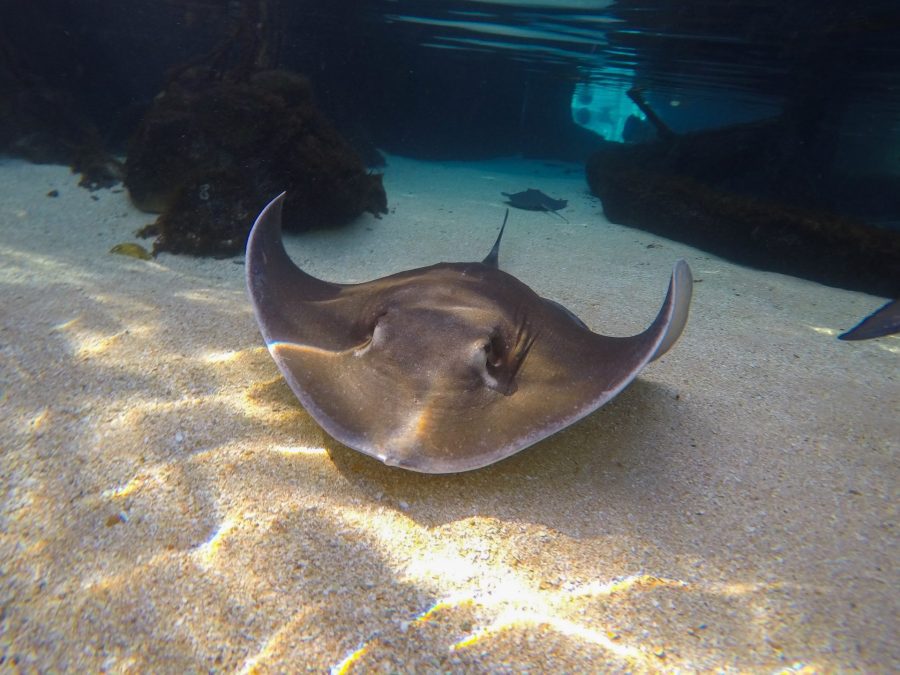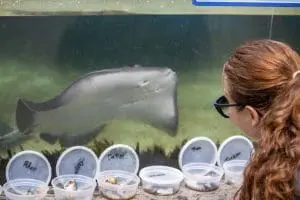

If you’ve visited the Brevard Zoo, you’ve likely met a lot of our more than 900 animal residents. Some animals are easy to spot, but others are often not as easy to see because of their habitat setup, their personalities, their sleep cycles, and other reasons.
That’s why we are starting a “Meet the Animals” section of our blog: to introduce you to some of the residents you may not have met yet – and might have difficulty meeting even if you intently looked for them!
If you’ve visited our Paws On loop, you’ve probably noticed our Indian River Lagoon-themed aquarium full of mangroves and fish. However, there are other inhabitants: our “fever”, or group, of stingrays!
We’re home to eight stingrays, six Southern stingrays and two Atlantic stingrays. Southern stingrays typically have more of a symmetrical diamond shape, while Atlantic stingrays have a tapered, pointy rostrum, which is their snout area.
Our rays cared for by our Herps & Aquatics animal care team. Here’s how our Herps & Aquatics area supervisor Nicole Payne described each of our rays:
Memphis – One of the most active stingrays, he is often seen swimming fast and flapping on the windows. When coming to feed, this 14-year-old dark brown Southern stingray almost always approaches from the left, swims the length of the front window really fast, and if you’re not quick enough with the food, he’s not waiting for you! The least picky eater of the fever, Memphis is ready to eat just about anything and will happily take everyone else’s leftovers if we let him.
Rhett – Often touted as “the sweetest” stingray, Rhett is a peaceful presence. Not one to flap and splash at us, this 14-year-old Southern stingray approaches calmly and will often wait patiently for us to bring him food. He is beloved by keepers and veterinarian staff alike, because whenever we do exams on any other stingray, Rhett never fails to come over and hover around the other ray while they’re in a recovery space. Rhett is gray with white speckles all over his top side.
Dallas – This 5-year-old Southern stingray is actually one of the first stingrays born at Brevard Zoo! Dallas is a bit more hesitant to approach new things or keepers in the water. He is often one of the last to show up at mealtime, but when he does, he’s all in! Fast approaching, jumping and flapping at us, eager-to-eat Dallas epitomizes “go big or go home.” He has the shortest tail of our rays.
Jasper – This 4-year-old Southern stingray was born at Brevard Zoo. Jasper is usually awake and swimming around before the other rays every morning. At mealtime, keepers have to be precise with food placement — if we don’t get the food lined up perfectly with his mouth, he often decides it’s not worth the effort to take it and will swim another lap before giving us another chance to get it right (he does great with puzzle feeders though!). Jasper is a bit picky with food, too, refusing to take certain kinds of fish or sizes of pieces.
Theodore – This 3-year-old Southern stingray was born at Brevard Zoo. “Theo,” as we know him, keeps surprising us with just how big he is. Essentially a full-grown stingray, he’s perpetually one of the babies in our heads. Theo is a very well-mannered stingray and will often sit on the sand by the feeding window until we make a sound cue to “invite” him up to eat. Not usually a picky eater, it is refreshing to work with a ray who eats all parts of his diet. Theo is smaller than some of our other rays, gray in color, and has a dark spot over his mouth on the ventral (under) side.
Wheeler – This 3-year-old Southern stingray was the last Southern stingray to be born at our Zoo before our females moved to another aquarium. Wheeler is just 3 months younger than Theo but significantly smaller, although he also is bigger than we picture him in our heads. Wheeler is a creature of habit and likes to sleep in the same spot every night. It must be a good spot, too, since Memphis used to sleep there until Wheeler pushed him over a few inches. Wheeler is the absolute pickiest eater of the bunch, but he LOVES shrimp. If he gets a taste of shrimp, he will often refuse everything else while waiting for keepers to give in and give him more shrimp, since now he knows we have it.
Trixie – Trixie is a funny stingray. This 9-year-old Atlantic stingray sometimes is absolutely ravenous, then other days she slowly approaches the feeding area several times to just turn around and wander off for a while. When she does come to eat, she tends to eat only on the substrate in the corner, never on the window like the other rays have learned to do. On days when she decides not to come to the front, we can usually use a sound cue to bring her to a side window more successfully. All of that in mind, it makes it even more surprising that she also has a history of sitting on top of keepers’ feet to ask for food. She has white marks on the edges of her wings.
Jackson – Jackson is a very active stingray and is usually seen cruising around the aquarium, often in pursuit of Trixie, who he is usually trying to “court” when the season is right. Often late to feed times, this 9-year-old dark brown Atlantic stingray will show up, act very interested in the food we offer, but also make it nearly impossible to get it close to his mouth. He presses his body so flat against the floor or window that we have to lever his fin up a bit to get food underneath him! Although small in stature, he is big in appetite and energy.
Our rays share their aquarium with five hermit crabs, two Atlantic tarpons, two black drums, five blackbar sheepshead seabreams, four common snooks, a grey snapper, a hardhead sea catfish, and three red drums. Although this is quite a few habitat-mates, everyone gets along, Nicole said.
“All of these species in this aquarium are local to our Indian River Lagoon, so they are species that would coexist naturally,” Nicole said. “The rays are often seen resting near each other, though they don’t have a social structure that would indicate any type of bonded relationships, and they don’t have any conflicts with the other fish nearby.”
 You may remember how in years past, guests were able to interact with our rays and even feed them. A few years ago, our animal care team looked at how to improve our stingrays’ health and well-being. One of those elements was how and what we feed them. For best health, it is recommended that stingrays receive 4-6 percent of their body weight in food per week. The amount of food received also determines the dosage of their daily vitamin supplement. To provide both accurately, we switched from a free-for-all style of feeding to individualized diets for each of the stingrays, allowing us to weigh out their portions and more closely monitor their food consumption.
You may remember how in years past, guests were able to interact with our rays and even feed them. A few years ago, our animal care team looked at how to improve our stingrays’ health and well-being. One of those elements was how and what we feed them. For best health, it is recommended that stingrays receive 4-6 percent of their body weight in food per week. The amount of food received also determines the dosage of their daily vitamin supplement. To provide both accurately, we switched from a free-for-all style of feeding to individualized diets for each of the stingrays, allowing us to weigh out their portions and more closely monitor their food consumption.
“To make sure each ray is getting the right diet, keepers who can tell them apart are now the ones who feed the stingrays,” Nicole said. “This also enables us to get a closer look at each stingray as they come up, so we can better monitor their health, body condition and skin condition, and check for anything that may be out of the ordinary.”
Our stingrays enjoy puzzle feeders as an enrichment. Their keepers stuff food into plastic or rubber balls, encouraging their natural foraging behaviors.
“They are great at crunching shells and sucking the meat out of shellfish, so feeder balls simulate that behavior,” Nicole said.
The stingrays are also intrigued by unique items to investigate and navigate around, such as long felt strips looking like kelp and vertically placed hula hoops. Bubble streams and special food items like mussels and crab legs get their attention as well.
Check out this blogpost if you’re interested in learning more about our stingrays’ eating habits.
We can’t end without some cool stingray facts! Stingrays are elasmobranchs, cartilaginous fish, and therefore are related to sharks —who ironically are also their biggest predator.
Stingrays have a skeleton made of cartilage instead of bone along with rows of teeth flattened into crushing plates. Their sensory systems enable chemoreception (smelling), electroreception (detects electrical impulses, like those muscles used to move or talk to the brain), and pressure-sensing.
“If you imagine all the traits that make a shark famous, but then make the animal flat, you get a stingray,” Nicole said.
